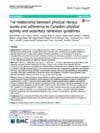Background
Physical literacy is an emerging construct in children’s health promotion, and may impact their lifelong physical activity habits. However, recent data reveal that only a small portion of Canadian children are regularly physically active and/or meet sedentary behaviour guidelines. To our knowledge, no study has investigated the association between physical literacy and movement behaviour guidelines. Therefore, the purpose of this study was to examine the relationship between physical literacy scores in Canadian children who meet or do not meet physical activity and sedentary behaviour guidelines.
Methods
Children (n = 2956; 56.6% girls) aged 8–12 years from 10 Canadian cities had their physical literacy levels measured using the Canadian Assessment of Physical Literacy, which consists of four domains (Physical Competence; Daily Behaviour; Knowledge and Understanding; and Motivation and Confidence) that are aggregated to provide a composite physical literacy score. Physical activity levels were measured by pedometers, and sedentary behaviour was assessed through self-report questionnaire. Analyses were conducted separately for each guideline, comparing participants meeting versus those not meeting the guidelines. Comparisons were performed using MANOVA and logistic regression to control for age, gender, and seasonality.
Results
Participants meeting physical activity guidelines or sedentary behaviour guidelines had higher physical literacy domain scores for Physical Competence and for Motivation and Confidence compared to those not meeting either guideline (both p < 0.0001). Participants had increased odds of meeting physical activity guidelines and sedentary behaviour guidelines if they met the minimum recommended level of the Physical Competence and Motivation and Confidence domains. Significant age (OR 0.9; 95% CI: 0.8, 0.9), gender (OR 0.4; 95% CI: 0.3, 0.5) and seasonality effects (OR 1.6; 95% CI: 1.2, 2.2 spring and OR 1.7; 95% CI: 1.2, 2.5 summer, reference winter) were seen for physical activity guidelines, and age (OR 0.8; 95% CI: 0.7, 0.8) and gender effects (OR 1.7; 95% CI: 1.4, 2.0) for sedentary behaviour guidelines. Knowledge and Understanding of physical activity principles was not related to guideline adherence in either model.
Conclusions
These cross-sectional findings demonstrate important associations between physical literacy and guideline adherence for physical activity and sedentary behaviour. Future research should explore the causality of these associations.



Responses